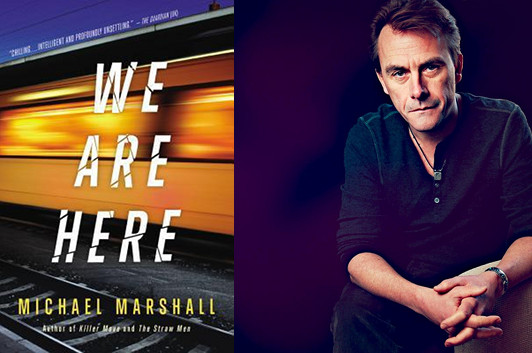Michael Marshall: Research & the Long-Distance Walker

photo via Michael Marshall Smith
When I met British novelist Michael Marshall back in 2009, he told me about the research he was doing for a novel set in New York City. Well, We Are Here is out now, so I asked him to tell us a little bit more about the wandering approach he took to the city as he was putting its story together.
I recently saw a bumper sticker that amused me: “I want to live in a world where chickens don’t have their motivations constantly questioned.” My feelings on research relate less to why fowl traverse thoroughfares, however, and more to the knotty chronological relationship that obtains between them and their storage solutions for developing embryos.
Because when it comes to research, I’m sill not sure if it’s the chicken, or the egg, that comes first.
We Are Here is largely set in New York City. For a long time the city and I remained strangers, with the exception of a week-long visit back in the late 1980s as part of a tour with the Cambridge Footlights. We performed our mannered and carefully-worded undergraduate sketch comedy to the bafflement of tough late night club crowds far more geared up for improv, and spent the rest of our time wandering streets that were, in those days, genuinely rather unnerving.
I didn’t return until the late 2000s, when a sequence of events and a policy of using the city as a hub to other destinations meant I found myself in NYC for anything from three to seven days on an annual basis. It had become somewhat gentrified by then, less openly alarming to the effete North London novelist I had become, and I discovered the truth that everyone else knows—that New York, along with Paris and London, is one of the world’s great triumvirate of cities. A great walking city, too—perfect for an inveterate high-speed flâneur and block-walker like me.
I’d previously done this with Seattle, on a solitary six-day trip, and established a method of sorts. I get up, leave the hotel around 9:00, and then walk solidly and pretty quickly—with breaks only for coffee and a quick lunch—until 5:00, at which point I return to the hotel, shower, and then read and make notes in the hotel bar until they tell me it’s really time to go to bed now, sir. Sometimes I’ll set a mission to provide an initial destination—the quest for some far-distant bookstore, or especially vaunted purveyor of chili—but more often I’ll walk randomly, following whatever unfolding route seems interesting (and sometimes hurriedly backing out again, if the neighborhood I find myself in turns out to be a little too interesting).
I went to Seattle because I knew my next book (The Intruders, currently in production as a TV series with BBC America) was going to be mainly set in the city: though I didn’t know where, or what many of the events would be, and thus what kind of locales they would require. I had a tenth of a chicken, or the shell of the egg. I went in hope of finding the rest, which I did.
It was the same with We Are Here. I realized that I needed a major urban setting for this story about friends and strangers, and the roles they play in our personal histories, and that New York City felt perfect—better than any other location in the world. Also that the city would not only hold the action, but hopefully become a character in it too. What I didn’t know was where, or which parts would become relevant, not least because I had (as is my tiresome writing method) very little idea at that point of what the hell was going to happen in the book.
Over the course of several visits, I followed my ‘technique’, walking 120-160 blocks a day, sometimes more. You can get up a lot of speed in New York, because of the grid pattern of much of Manhattan, and if you go with whichever pedestrian crossing happens to have a green light every time you hit an intersection. I walked up and down and round and round. After a while my circles started to get tighter, and tighter, and I honed in on a few locales—one corner of Soho, the East Village, NoLiTa, a section of midtown in the West 40s-50s, and a few specific locations, like Bryant Park and Old St Pat’s church and a not especially interesting stretch of 16th Street close to Eighth Avenue. I didn’t even know why I was fastening upon these places. Sometimes I go looking for places to set events I already have in mind. At others I find locations, and they suggest the events.
The chicken comes first, but so does the egg. And somewhere in the relationship between them coalesces a novel. I can’t necessarily recommend this approach, as it can lead to periods of ear-bleeding confusion and doubt, but it’s how I do. And it’s how life works too, of course. We perform actions in order to make things happen: but things happen, too, and cause us to perform actions as a result. Causality is not a one-way street, and neither is the relationship between research and creation. Research is a type of creation, or can be. I don’t want to impose a plot upon a novel. I would rather discover it within what transpires on the page in front of me—and in this case, growing of what I found, by accident, amidst the streets of New York.
28 February 2014 | guest authors |

 Our Endless and Proper Work is my new book with Belt Publishing about starting (and sticking to) a productive writing practice.
Our Endless and Proper Work is my new book with Belt Publishing about starting (and sticking to) a productive writing practice. 
